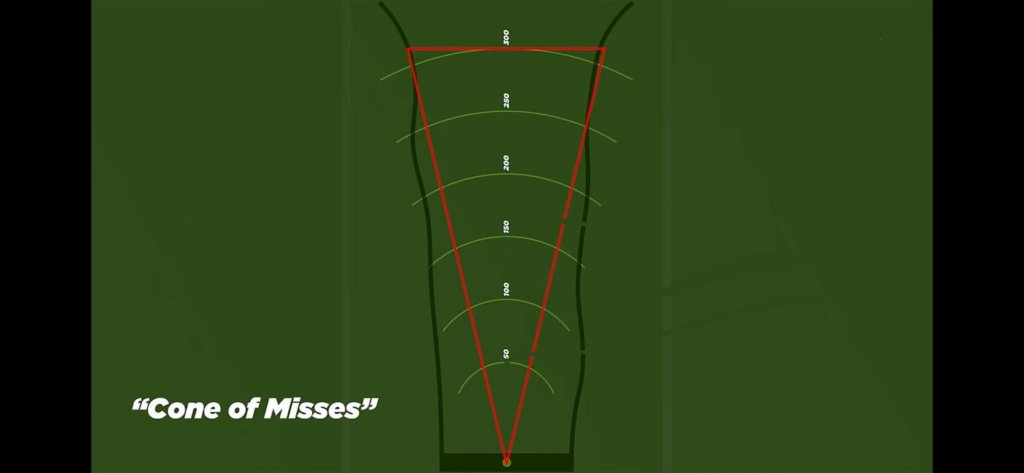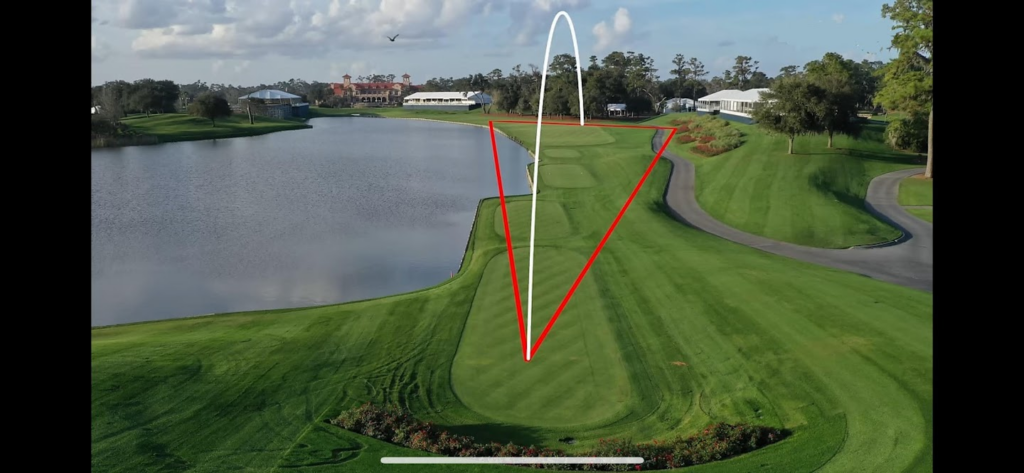Improving your golf game goes beyond just honing your swing technique; it involves mastering the strategic aspects of play that can significantly lower your scores. This comprehensive guide delves into the art of strategic aiming and course management, inspired by the principles of the DECADE Course Management System developed by Scott Fawcett. From understanding the crucial “cone of misses” to assessing risk versus reward and applying these insights on the golf course, this guide aims to equip golfers at all levels with the knowledge to make smarter decisions, aim like the pros, and navigate the course with confidence. Through a blend of statistical analysis, personal reflection, and strategic planning, golfers can unlock new levels of performance, transforming their approach to every shot and every hole.

Introduction to Strategic Aiming
Golf is a game of precision, skill, and strategy. Not only is it about how well you hit the ball, but also about where you aim and how you navigate the course. Strategic aiming is crucial in golf because it determines the potential success of every shot you take. It involves more than just aiming for the fairway or the green; it’s about making informed decisions that consider the risk versus the reward, understanding your own abilities, and playing in a way that maximizes your chances of scoring well.
The Importance of Strategic Aiming in Golf
Strategic aiming goes beyond the basic concept of trying to hit the ball straight. It involves selecting targets that offer the best chance for success based on your skill level and the current conditions of the course. This means sometimes aiming away from the flag to a safer area of the green to avoid hazards, or choosing a club that won’t reach the bunker at the end of the fairway. The right aiming strategy can significantly reduce your scores and make the game more enjoyable by minimizing the risks of difficult shots.
Introduction to the DECADE System
The DECADE Course Management System, developed by Scott Fawcett, has revolutionized the way golfers approach the game. DECADE stands for Distance, Expectation, Correct Target, Analyze, Discipline, Execute. This system uses statistical analysis to help golfers make smarter decisions on the course. By analyzing shot distributions and outcomes from a wide range of players, the DECADE system provides insights into where to aim and how to manage the course strategically.
Relevance to Aiming and Course Management
The DECADE system emphasizes the importance of selecting the correct target based on a combination of distance, expected outcomes, and the golfer’s ability to execute the shot. It encourages players to think several moves ahead, much like in chess, by planning their shots and aiming strategies with a deep understanding of their own game and the challenges presented by the course. This strategic approach to aiming can lead to more consistent scores and a reduction in mistakes by avoiding unnecessary risks.
In summary, strategic aiming in golf is about making informed decisions that consider the golfer’s strengths and the course’s challenges. The DECADE system offers a structured approach to improve aiming and course management, which can help golfers of all levels play more intelligently and lower their scores. By applying principles from the DECADE system, golfers can learn to aim like the pros, making decisions that favor long-term success over short-term gains.
Understanding the “Cone of Misses”
In golf, precision and accuracy are not just about hitting the ball in the right direction; they’re about understanding and managing where your shots could end up, including the less-than-ideal ones. This is where the concept of the “cone of misses” comes into play, offering a strategic framework for improving your game by acknowledging and planning for variability.
Explanation of the “Cone of Misses” Concept
The “cone of misses” refers to the anticipated area where a golfer’s shots are likely to land, considering their accuracy and consistency. Imagine standing at the tee and visualizing a cone-shaped area extending outwards from you to the fairway or green. The wider part of the cone represents the range of potential outcomes of your shot, including the furthest deviations to the left and right that your ball might end up. This concept acknowledges that not every shot will be perfect, but it helps golfers plan for the likelihood of where their misses will land.
Significance in Golf Strategy
Understanding and utilizing the “cone of misses” is crucial for several reasons. It allows golfers to choose safer targets that accommodate their typical miss patterns, thereby reducing the risk of landing in hazards or out-of-bounds areas. Strategically, it encourages players to aim in a way that the worst outcomes of their shots still leave them in a playable position, thus minimizing the potential for big scores on any given hole.
How the “Cone” Varies for Different Skill Levels
The size and shape of a golfer’s “cone of misses” can vary significantly based on their skill level. Higher skilled players tend to have a narrower cone, indicating greater consistency and accuracy in their shots. In contrast, beginners or higher-handicap golfers might find their cone much wider, reflecting a broader range of potential outcomes.
Why Understanding Your Own Cone is Critical
Understanding your own “cone of misses” is critical for effective course management and strategic planning. By knowing the typical patterns and spread of your shots, you can make informed decisions on target selection, club choice, and risk management. For instance, if your cone of misses tends to skew right, planning your shots to account for this bias can help keep you out of trouble and improve your scoring opportunities.
In summary, the “cone of misses” offers a practical framework for golfers to manage their expectations and plan their shots more effectively. By acknowledging the reality of variability in shot outcomes, golfers can strategize to minimize risks and set themselves up for success, regardless of their skill level. Understanding and applying this concept is a key step toward playing smarter and shooting lower scores.

DECADE System and Aiming Strategy
The DECADE System, conceived by Scott Fawcett, has emerged as a transformative approach in golf, integrating statistical analysis with strategic planning to revolutionize how golfers approach each shot. This system empowers players to make informed decisions on the course, focusing on optimizing their performance through a structured framework. Here, we’ll explore the components of the DECADE system and how it enhances aiming and shot selection for golfers.
Overview of the DECADE System
The acronym DECADE stands for Distance, Expectation, Correct Target, Analyze, Discipline, Execute. Each element of the system plays a crucial role in guiding golfers through the process of making strategic decisions during a round of golf.
- Distance: Understanding the specific distances you are capable of hitting with each club, taking into account various conditions like wind and elevation.
- Expectation: Setting realistic expectations for each shot based on your skill level and statistical likelihoods.
- Correct Target: Choosing the most strategic target for each shot, which may not always be the pin, based on the analysis of risks and rewards.
- Analyze: Reflecting on past performances and current conditions to make informed decisions.
- Discipline: Maintaining a disciplined approach to stick with the strategic plan, avoiding impulsive decisions based on emotions.
- Execute: Finally, focusing on executing the shot as planned, with the correct technique and mental focus.
Integrating Statistical Analysis and Strategic Planning
Enhancing Aiming and Shot Selection
The DECADE system utilizes statistical analysis to provide golfers with a comprehensive understanding of their own game and how it compares to the expected outcomes at various skill levels. By analyzing vast amounts of data on shot outcomes, the system identifies patterns that can inform smarter aiming strategies and shot selections.
- Statistical Analysis: DECADE leverages data from both the player’s personal performance and broader golf statistics to highlight where improvements can be made. This includes understanding the probability of outcomes based on different aiming strategies and how adjustments can lead to lower scores.
- Strategic Planning: With a focus on long-term performance improvement, DECADE encourages golfers to plan their rounds strategically. This means considering the safest targets that align with their skills and the course’s challenges, effectively turning high-risk situations into manageable scenarios.
By focusing on where to aim and how to approach each shot, golfers can reduce their scores and play more consistently. The DECADE system’s emphasis on discipline and execution ensures that players remain committed to their strategic plans, even under pressure. This holistic approach to golf strategy teaches players to manage the course intelligently, leveraging their strengths and minimizing exposure to risks.
In essence, the DECADE system offers a roadmap for golfers to refine their aiming and shot selection strategies, grounded in statistical evidence and tailored to individual capabilities. Its comprehensive framework guides players through making calculated decisions that can lead to significant improvements in their overall performance.
Assessing Risk vs. Reward
In golf, the decision to take an aggressive line off the tee or into greens is a critical aspect of strategic play. It involves weighing the potential benefits of a more direct or challenging route against the risks of encountering hazards or difficult positions. This section explores techniques to evaluate these decisions and provides examples to illustrate when taking an aggressive line might be beneficial and when it could lead to unnecessary penalties.
Techniques to Evaluate Risk vs. Reward
Evaluating the risk versus reward of aggressive shots requires a careful analysis of several factors, including your skill level, the course layout, and current playing conditions. Here are some techniques to help make these assessments:
- Statistical Analysis: Utilize data and statistics from your past rounds to understand your strengths and weaknesses. Knowing the likelihood of success with various types of shots can inform your strategy.
- Scenario Simulation: Mentally simulate different outcomes of the aggressive shot versus a safer play. Consider the best and worst-case scenarios for each and how they could impact your score.
- Understand Course Design: Gain a thorough understanding of the course layout, noting where hazards are placed and identifying bail-out areas. Courses are often designed to reward strategic play over pure aggression.
- Know Your Game: Be honest about your abilities. If you have a high success rate with a particular shot under similar conditions, the aggressive play might be justified. Conversely, if a shot consistently leads to trouble, opting for a safer approach is wise.

Examples of Risk vs. Reward Decisions
When Aggressive Play is Justified
- Short Par-4 with Accessible Green: If there’s a short par-4 hole where reaching the green in one shot is within your capabilities, and the risk of hazards is minimal, going for the green can significantly increase your birdie chances.
- Favorable Wind Conditions: On days when the wind is at your back, taking an aggressive line over a hazard to shorten the hole may have less risk and can set up an easier approach shot.
When to Opt for a Safer Approach
- Tight Fairways with Hazards: On holes where fairways are flanked by water or bunkers, and the landing area for an aggressive drive is minimal, opting for a shorter, more controlled tee shot that ensures staying in play may lead to a better overall score.
- Difficult Pin Positions: When the flag is placed close to hazards or the edge of the green, aiming for the center of the green rather than attacking the pin directly can avoid costly mistakes, especially when the surrounding area penalizes misses harshly.
In summary, the decision to take an aggressive line in golf is a complex one, requiring a nuanced understanding of your own game, the course, and the conditions on the day of play. By applying the above techniques and considering the examples provided, golfers can make more informed decisions that balance the potential rewards against the risks, ultimately leading to lower scores and more enjoyable rounds.
Continue…
- See Also : Strategic Aiming: Lessons from the Tour Pros #02
- See Also : https://decade.golf/
Leave a Reply